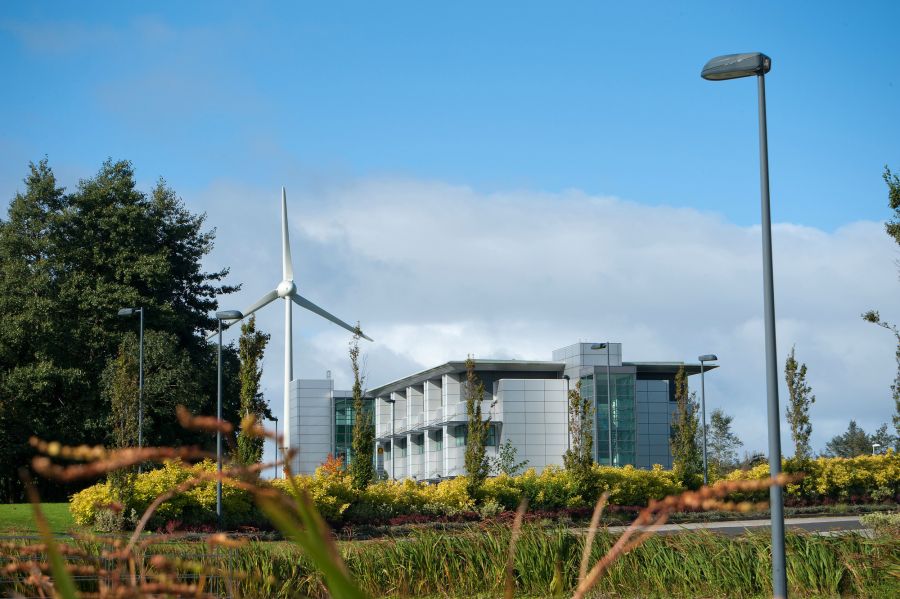Page content
Water

Biodiversity
The primary objective of any landscaping should be to create a pleasant, aesthetic environment for staff, students and visitors to enjoy.
The maintenance of the University’s amenity gardens, lawns and sports facilities aim to achieve this.
The University’s grounds are also maintained to promote biodiversity and minimise environmental impact, with the following practices in operation where feasible to do so.
- Shrub beds are typically hand weeded to minimise chemical use.
- Shrub beds are mulched to control weeds.
- No chemicals are routinely applied to control weeds on sports pitches.
- Dead trees are left standing, and fallen trunks left lying on the ground.
- Significant areas of the University’s campus, mostly on the Coleraine and Jordanstown campuses, are left wild to enhance habitat provision.
- Where trees need to be felled, they are chipped on site with the wood chip retained for use on campus as mulch in shrub beds.
Coleraine campus
The University’s Coleraine campus is set within 312 acres of landscaped and mature parkland containing tranquil gardens, a daffodil garden and the Millennium Arboretum. It is estimated that approximately 19% of the campus is composed of woodland.
The site prior to construction of the University was essentially open farmland. The resultant changes to the site have therefore improved its biodiversity considerably.
A survey completed circa 2000 estimated that there were in the region of 90,000 trees on campus.
As well as the substantial tree planting that has taken place over the years, there have also been corresponding developments in hard landscaping, shrubs and herbaceous and bulb planting.
Throughout the campus there are several specialist garden areas that are open to the public.
The Millennium Arboretum is spread over six sites on the campus, comprising of over 100 tree varieties. It was created over a four year period, between 1998 and 2002 and at the time it was the only one of its kind in the United Kingdom and Ireland.
Electricity

Carbon management plan 2010/11 to 2020/21
The University’s carbon management plan outlines the University’s strategic approach to carbon emissions reduction through improved energy and water efficiency, greener procurement, more sustainable travel and improvements to waste management over the period. It also details the key reduction measures required and a proposed implementation process to realise the reduction targets.
The plan commits the University to a target of a 29% reduction in carbon emissions by 2020/21, from the baseline year of 2005/06.
The carbon management plan sets out a framework which:
- Establishes the University’s baseline carbon emissions
- Defines the scope of carbon emissions included within the plan
- Sets targets for reducing carbon emissions
- Details an initial set of carbon emissions reduction projects
The University’s carbon management plan 2010/11 to 2020/21 can be viewed below:
Construction and refurbishment
Replacing inefficient building stock and refurbishment of existing buildings together offer the greatest potential to improve environmental performance.
With this in mind the University has incorporated sustainability into its estates development strategy. A key part of this is the implementation of the Building Research Establishment’s Environmental Assessment Method (BREEAM), which is widely recognised as the world's leading design and assessment method for sustainable buildings.
Currently, the University requires all new buildings to achieve an ‘excellent’ BREEAM rating and major refurbishments to achieve a ‘very good’ rating.
The University also considers sustainability within its minor refurbishment works programme and carries out specific energy efficiency and renewable energy projects.
The effective management of energy has been a key strategic objective within the University for many years, having been at the heart of its estates strategy for the past two decades.
The University has developed a ten year carbon management plan for the period 2010/11 to 2020/21, a key element is the reduction in carbon emissions arising from the consumption of energy. The plan has targeted a 29% reduction in carbon emissions associated with energy consumption by the end of the plan, based on a 2005/06 emissions baseline.
The key areas where energy efficiency has, and will continue to be focused are as follows;
- Via sustainable new build, major refurbishment and rationalisation improve the energy efficiency of the University’s physical estate.
- The introduction of more sustainable, energy efficient technology to replace existing inefficient and/ or aged plant and equipment.
- Improvements to building fabric and building management system controls.
- Enhanced metering of the University’s utilities supplies to identify and reduce wastage.
- Increased awareness and communications promoting energy conservation behaviours amongst staff and students.
Please visit our carbon management page to find out more.
Energy audit and Reviews
Energy at the university is managed by the Asset Manage Team who have developed a process for energy auditing and reviews using both remote monitoring systems and on campus inspections. The Asset Management Team conduct energy audits on a regular basis to help identify energy waste and opportunities for improving energy practices which aids reduction in carbon emissions. See below example of energy management and review in practice.
Low carbon technologies
In its efforts to improve energy efficiency and reduce carbon emissions associated with the consumption of energy, the University has introduced several low carbon technologies within its estate.
Wind turbine on Coleraine campus
An 800 kW wind turbine generator has been installed on the Coleraine Campus since September 2008. It produces approximately 1.6 MWh of renewable electricity annually, which equates to approximately 24% of the campus’ total electricity requirement.
Solar photovoltaic (PV) arrays
- A solar wall installed in the Harry Ferguson Engineering Village on the Jordanstown Campus producing approximately 5,000 kWh of renewable electricity annually.
- A 26 kW PV Array on the roof of BB Building on the Belfast campus producing approximately 20,000 kWh of renewable electricity annually.
- A 25.5 kW PV Array on the roof of Block I on the Coleraine campus producing approximately 20,000 kWh of renewable electricity annually.
- A 50 kW PV Array on the roof of MF Building and a 12 kW PV Array on the roof of MP building on the Magee campus producing approximately a total of 50,000 kWh of renewable electricity annually.
Combined heat and power (CHP)
CHP units are installed on the Jordanstown and Belfast campuses.
The CHP unit in Jordanstown has been installed since 1997, with a further two units in Belfast installed as part of the major refurbishment of the Warwick Building which was completed in 2008.
CHP generates electricity whilst also capturing usable heat that is produced in this process. This contrasts with conventional ways of generating electricity where vast amounts of heat is simply wasted. This results in the CHP unit being much more efficient.
The CHP system in place in Belfast is even more efficient as it is linked to an absorption chiller, which allows the energy from the captured heat which is simply ‘wasted’ in the summer months (where no heating is needed) in conventional CHP systems to be used for cooling purposes. This type of arrangement is known as a tri-generation system.
Ground source heat pumps
A ground source heat pump system is installed on the Jordanstown campus, servicing the High Performance Sports Centre. The system essentially extracts heat from the ground through a series of underground pipes which the pumps are connected to. The heat ‘stored’ in the ground is used to improve the energy efficiency of the heating system in the centre.
Water leak discovered due to automatic metering and targeting software; Leak hadn’t come to surface level yet.
Burst water pipe resulting in daily consumption peaking at 16.79 m³, up c. 16.00 m³ / day from baseline.
Undiscovered, this leak would have cost c. £60 per day in water volumetric and sewerage charges.
Half hourly electricity consumption. Consumption typically decreases during the day, however as circled above, consumption increased towards close of business. This was found to be caused by use of electric heaters, causing a spike of c. 5 kWh. Although minor, this wastage was flagged automatically with an alarm on the automatic metering and targeting software, enabling the cause to be promptly investigated and resolved.
Waste
As a result of its daily activities, the University generates significant quantities of waste.
The majority of this waste is non-hazardous in nature and includes waste paper, plastics, packaging and food generated in offices, lecture/meeting rooms, catering outlets and shops.
The food waste is separated where possible, with the majority of the remaining waste collected by the University’s appointed waste contractors and taken off site for processing in materials recovery facilities (MRFs) in Belfast and Ringsend (just outside Coleraine).
These MRFs allow the waste materials to be sorted and sent for either recycling, energy recovery or disposal to landfill.
This is a very effective process resulting in the majority of the waste being diverted from landfill disposal.
Other waste streams are collected separately and sent for recycling. These include electrical equipment, cardboard, glass, cooking oil, fluorescent tubes and printer/toner cartridges.
The University has made considerable improvements to waste management practices over the years, and is committed to managing waste in accordance with the waste hierarchy shown below. With this in mind, the University has set a target to minimise the amount of waste it produces.
Ink Cartridge Recycling
All university ink cartridges can be returned to our stationery supplier, upon request.
E: Banner@RecycleYourCartridges.co.uk and share the following details:
- Company Name:
- Contact Person:
- Street:
- Post code:
- City:
- Country:
- Phone:
- Email Address:
- Number of empty boxes to be despatched and / or number of full boxes on site to be collected
Alternatively the ink cartridges can be donated to charity: Both Empty Cartridge and The Recycling Factory recycle cartridges with the money being donated to a charity of the supplier's choice.
Battery Recycling
Please dispose of household batteries in the battery disposal box held at main reception.
Waste Electronic and Electrical Equipment (WEEE) Recycling
WEEE (PCs, Printers, Monitors, Mobile Phones etc.) recycling is managed by Digital Services but supported by Estates Customer Services (Facilities Services section).
Further information on the recycling procedure and service can be found from the following link:
Warp It
Warp It is part of Ulster’s ‘Climate Smart’ environmental sustainability engagement initiative. Find, give away, or loan office furniture, equipment and other resources.
Water
As part of its everyday activities, the University consumes significant quantities of water.
Key areas where water is used are in kitchens, toilets, laboratories, showers and during grounds maintenance activities.
The University actively monitors its water consumption and has a proactive programme in place to minimise its use.
Programmes include the installation of water conservation appliances and fittings, leak detection surveys of underground pipework and raising awareness amongst staff and students.
A grey water recycling system is also installed on the University’s Belfast campus, which collects rainwater from the roof for use in the building’s toilet facilities.

















